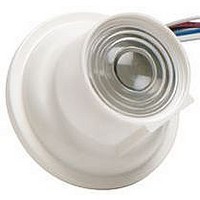DHIP HUBBELL WIRING DEVICES, DHIP Datasheet - Page 8

DHIP
Manufacturer Part Number
DHIP
Description
Daylight Harvesting Indoor Photocell
Manufacturer
HUBBELL WIRING DEVICES
Datasheet
1.HMHBSA.pdf
(28 pages)
Specifications of DHIP
Peak Reflow Compatible (260 C)
No
Leaded Process Compatible
No
For Use With
H-MOSS Motion Sensing Switches
Lead Free Status / RoHS Status
Contains lead / RoHS non-compliant
H-MOSS
Hubbell Motion Sensing Switches
for an Energy Conscious World
Energy Saving
Locations:
Supply Closets
Restrooms
Changing Rooms
Break Rooms
Offices
Hallways
Show Floor
Pro Tip:
Passive infrared is perfect
for changing rooms, and
break areas where ROI
outweighs performance
requirements.
Success Factors:
• Minimize cost and
• Reduce the chance
• Contact you local
8
* Energy Information Administration:
** Based on 40% lighting savings
maximize savings in
changing rooms with
PIR sensors and short
off delays.
for sensor damage by
specifying the hard
lenses of the AD and
AP series.
Hubbell sensor
professional for
assistance with high bay
storage and show floor
solutions.
2003 Commercial Buildings
Energy Consumption Survey
from sensors.
Actual results may vary.
®
Retail Solutions
Payback
Faster
Typical Retail Electricity Usage and Savings
Based on average occupancy and installation complexity.
Lighting Uses 53% of Total Electricity
15%
Other
Application ROI Index
Refrigeration
10%
Lighting
53%
Climate Control
22%
Illuminate sales potential and
increase profit.
Retail establishments use a significant amount
of electricity for lighting—both for overhead
and display. After all, customers need to
clearly see what they’re buying. However,
there are numerous areas in stores that
don’t require light all day like stock rooms,
restrooms, and fitting rooms. Occupancy
sensors in these areas can lower a store’s
electricity bill and increase profit.
The upgrade that pays back.
Hubbell’s H-MOSS sensors provide a
transparent, automated system that
seamlessly makes sure lights are turned
on when needed and off when they’re not.
Employees can carry goods in and out of
stock rooms without worrying about lights,
and patrons can enter instantly illuminated
fitting rooms. Occupancy sensors also show
customers that a retail establishment is
committed to minimizing energy waste while
saving money every day.
Savings
21%
Average electricity
bill savings**
*













